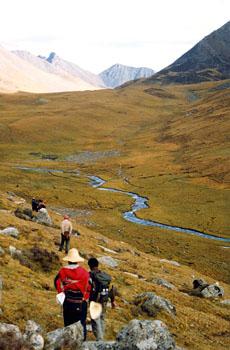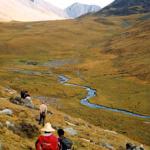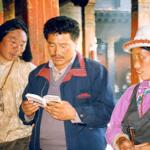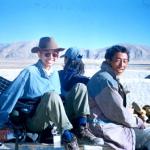Four Women in Tibet: The Journey to Everest
"Looking for fellow travelers to trek to Everest Base Camp. See April at the Yak Hotel."
Two days after I post this notice around Lhasa, four women have joined forces in the name of Everest. Now we just have to get there.
The crew consists of four solo travelers anxiously exploring the world and our selves. There's Angelique, a feisty Hawaiian who teaches English in Japan; Jenny, a Canadian woman fresh out of Princeton, roaming Asia to better understand her Chinese ancestry, Karen, a photographer from Olympia, Wash., who quit her government job to volunteer in the Himalayas; and myself, a transient San Franciscan on a year-long pilgrimage around Mother Earth.
For worshippers of superlatives, Mt. Everest is Earth's ultimate Mecca. An earthling can aspire no higher than the 29,000-foot mountain straddling Nepal and Tibet. Tibetans call her Chomolongma, "Goddess Mother of the Universe."
Though well worth the effort, traveling to Everest isn't easy. The People's Republic of China (PRC), Tibet's tyrant since 1950, forbids independent traveling in Tibet. Public transport is scant; hitchhiking is risky. A driver who picks up hitchhikers may risks a year's salary in fines and Tibet's high, remote roads are no place to be stranded.
Despite the bureaucratic hurdles, it's fairly simple to get into Tibet from Chengdu, capital of China's Sichuan province. There you can buy a basic tourist package, which includes the flight and accommodation in Lhasa. Once in Lhasa, most travelers band together and rent a 4WD for $100 to $200 U.S. a day. A common journey follows the "Friendship Highway" to Nepal's border, stopping at Everest en route.
Tourists must purchase a permit from China's Public Security Bureau to do anything more than breathe in Tibet (not easy, considering Lhasa is 12,000 feet above sea level). This serves a dual purpose: to collect as much money from travelers as possible and to scare them into staying on the touristed track. The PRC also charges foreigners at least double the Chinese price on everything from local parks to train tickets.
Against all odds, we decide to shirk the FWD option and make our own way to Everest. We have slim budgets and open calendars - why not travel in the hardy spirit of Tibet? First, the gang will take a bus from Lhasa to the city of Shigatse. From there we'll try to hitch to Tingri, where the foot path to Everest begins. We will hire yaks there to carry our packs - a slight concession to comfort. Finally, we will lace our hiking boots for the three-day trek to Everest Base Camp.
For Tibetans, the journey is as sacred as the destination. Rather than scaling a holy peak, they walk around it. This clockwise walk, called a kora, can take an hour for a monastery, or a week around one of Tibet's many hallowed lakes or mountains. The harder the pilgrimage, the more the merit. Western and Tibetan wayfarers converge on the Barkhor, the kora around Lhasa's Jokhang temple. Pilgrims have prostrated before the Jokhang's red doors for 1,300 years. The temple houses a lavishly brocaded Buddha, the most revered statue in Tibet.
The Barkhor circuit is like a Buddhist carnival. Smiling, wrinkled ladies mumble mantras and hold out hands for a few Jiao (cents) to help fund their long journeys. Young men sporting red-tasseled braids and chunky turquoise necklaces play pool at outdoor tables. Monks and nuns in maroon robes and sneakers turn hand-held prayer wheels, sending the words into the wind. Salesgirls snap their gum as they call out to customers. Their tables are spread with prayer beads, silk mandalas, altar lamp-butter, oversized sunglasses and Chicago Bulls caps.
Yes, Chicago Bulls caps. Since China opened Tibet's doors to tourism in 1984, its markets have been flooded with foreign merchandise - influences the Buddhist theocracy had managed to keep out for centuries. Shops offering e-mail, film processing, banana pancakes and fleece jackets now ring the Barkhor.
Tibetans have become a minority in their own capital. To integrate Tibet into the Motherland, the PRC has shipped in thousands of Chinese workers. The government rewards patriots who endure Tibet's extremes with salary bonuses and permission to have extra children. Much of Lhasa now resembles the rest of urban China - crappy concrete buildings lacking style and soul. Chinese tourists travel long distances to visit the Potala, now eerily empty. The Dalai Lama reigned from this palace until he fled to Indian exile in 1959. Thanks to the PRC's mastermind propoganda, most Chinese truly don't know what their government has done. The PRC has desecrated Tibet's monasteries, destroyed its environment, and killed and tortured more than one million Tibetan people.
***
We walk to the bus station in blackness. It takes an hour for the minibus to fill up with passengers for Shigatse. The Friendship Highway turns out to be a rocky, dirt road; its bridges are washed away. As the bus hobbles over boulders, I marvel at the fact that Tibet's roads have been upgraded since China's takeover.
In Shigatse, we stock up on yak jerky, waxy chocolate, "glucose biscuits" and Ramen noodles for the trek ahead. We comb the streets for a truck willing to take us to Tingri; the best offer is 1,700 yuan ($225 U.S.). We decide to take the morning bus to Lhatse, the last place along the Friendship Highway served by local public transportation.
Our fortune changes at 10 pm. During dinner, Karen spots the man who drove her from Nepal to Lhasa. He is headed back to Lhasa, but agrees to go to Tingri for 250 yuan ($35 U.S.) a head. We will leave at 5 am. The good-karma girls are on the move again.
***
The hour comes quickly. We crowd into the back of the Land Cruiser we once snubbed. The moon, full and bright, shines cool light into our window. She symbolizes the power pulsing through us.
The moon dives behind the foothills, purple and red in morning's first light. Everyone gasps for air as the vehicle mounts a 17,000-foot pass. We easily pick out Everest's face from a line-up of white pyramids: the Himalayas.
At last we pull into Tingri, a dinky village overrun by young ruffians. Yak carcasses are strung up along the road; nomads' yak-hair tents dot the fields behind Tingri's few restaurants and ramshackle hotels.
We ask around about yaks. A man canvases the town to see what's available. We end up cutting a deal with a shifty man named Gasadenda: 200 yuan ($25 U.S.) a day for two yaks plus his herding services. Tomorrow we hike.
PART II
Waking in Tibet is like entering a dream. I rise with the sun and look out on the land. Nomad's tents sleep in the shadows of foothills, themselves eclipsed by snowcaps. Two girls catch me snapping photos from the hotel's roof and shout up for toothpaste and Dalai Lama pictures. Thanks to travelers like us, Tingri has lost its innocence.
Gasadenda arrives an hour late and loads his horse cart with our packs. We blaze through town singing "Jingle Bells." There is reason to be jolly; we are on our way to the top of the world.
The trek to Everest base camp isn't as daunting as it sounds. It takes just three to five days, no climbing equipment or expertise necessary. Our goal is to make it to Rongphuk Monastery, just shy of base camp, in three days. We have brought along trail notes to the "advanced base camp," in case we feel up to it. Altitude sickness can strike anyone at any time at these heights, though, and Karen has only been in Tibet five days. Scary stories abound on Tibet's trails - often about people who pressed on despite their bodies' limitations. We agree to hike safely.
At last we come to Gasadenda's home. By Tibetan standards, it is ornate and spacious. Red, lacquered cabinets and hand-painted Buddhist symbols brighten the mud walls. Gasadenda proudly shows us a small memorial room. The altar teems with icons, butter lamps and musical instruments; a full-color photo of the Dalai Lama holds the place of honor. Not so long ago, a Tibetan might be jailed or tortured for owning a picture of the religious leader.
His mother serves us milk tea, (probably kept for foreign visitors, since Tibetans usually drink yak butter tea), and tsampa, roasted barley flour mixed with water. Gasadenda's dad loads two massive yaks after supper.
"Kalay pay (go slowly)," he says in parting.
"Kalay shu (stay slowly)," we answer.
The so-called trail (really a local cart road) takes us across a flat, rocky tract of tough grasses and bushes. A few puddles hide in the tall orange reeds; their waters catch glimpses of rosy peaks and clear skies. We walk in reverent silence, happy to be alone on the trail.
After a few hours, we reach a group of villagers working a small plot of land. Two boys run up to us. Their eyes are red from wind and smoke, hair powdered white with dust, skin hard like armor.
Gasadenda unloads the yaks, claiming they have to rest here for the night. We want to walk on since it's only 3 p.m. and we have a long haul ahead. He refuses, so we follow him and the boys into his friend's house.
We are singing campfire songs and washing up the kids when their mother comes in. She looks baffled at the sight of strange girls invading her home. The mother tells her boys not to eat our plastic-wrapped treats, though she admires our books. We give her gifts of soap, thread, pencils and tea. When the family finally starts their dinner at 9 p.m., we are already inside our down cocoons.
The girls are ready to go by 7 a.m., but Gasadenda stalls again. We figure out that he is trying 1) to both time our departure with a tour group that arrived late last night and 2) to also add another day to our trek.
When we finally hit the trail, Jenny and I lead the pack up into the hills. Karen isn't feeling well when we break for lunch. The altitude medicine is making her woozy and nauseous. Gasadenda urges us to stop for the day, but we selfishly, foolishly push on. As we cross a long, rocky expanse, our friend is almost crawling. We finally come to a huge hill we must climb over in order to set camp. Karen slowly inches her way over and collapses. We set up camp and prepare a prized box of Mac and cheese for our companion, filling her tent with emergency cans of oxygen. Karen is exhausted from our 9-to-5 hike, but otherwise okay. The night is miserably cold; the zipper on my cheap Chinese tent breaks on the first tug. By morning, our water supplies and socks are frozen.
We start out our third day panting, as we mount the Pang-La pass. We have long left behind any hint of trail. The only way is up. Finally we make it over, reaching a green river valley. We cross the river on a rickety log bridge. The mother mountain reappears, her facets sparkling like a diamond.
Five hours into the day, my energy gives out. A terrible abdominal cramp takes over, expanding with every breath. There is no more water and my mouth feels like a desert. Each step takes a miracle of mind-over-matter. I want to give up and lay down. At last, Gasadenda tells us we have just an hour to go.
Rongphuk Monastery finally appears on the horizon; prayer flags, whipped by the wind, welcome us inside. We are near the mountain's feet at last. I can feel her icy breath and see the texture of her tough snow coat, its folds purple with shadow.
A mean-faced monk shows us to a small room in the monastery's guest house. Huddled under two thick blankets, I wear two shirts, two sweaters and a coat to bed. Still, I wake up so dead cold and tired that I can barely sit up. Gasadenda bursts into our room requesting money for accommodations.
"Bring in the monk who wants money," I snap.
He comes back saying it's no problem after all. Then he asks for my walkman.
Tired of Tibet's rough traveling, Angelique, Jenny and I decide to thumb it back to Kathmandu. Amazingly, Karen still wants to hike back. We persuade her to hitch with us, provided we stay awhile with Everest.
Land Cruisers invade the monastery in the afternoon. Karen and I get a ride to base camp with a Chinese stud who grabs my knee as the car rounds the curves. It saves us the two-hour walk from Rongphuk.
When we get to base camp, Angelique and Jenny are chatting with three European climbers who just came down from a failed ascent. Now they are going to Nepal and taking our friends with them. A Chinese camera crew also filmed the girls; Angelique told the reporter that his government has made it a bitch to get here.
We walk back to Rongphuk, constantly turning around to see Everest. She changes colors as the sun sets, settling on pink for the final moment of light.
Gasadenda has been awaiting our return. The audacious guide wants gifts for his services, on top of his free trip home. We give him the dregs of our food and clothes and hope to never to see Gasadenda again.
Jenny and Angelique ride away with the handsome mountain men the next day. Karen and I spend another day cursing the cold and admiring Everest. Finally, we find a truck taking some Sherpas back to Nepal. The driver is scared to take us, but we convince him by showing him our travel permits.
Riding away from the monastery, the truck climbs a steep road until the snowy beauties are side by side. With each bend in the road, the highest point on earth swings like a pendulum. It marks another step of my kora around the world. Soon, this long dream will bring me back to my own bed.
* * * * *
Originally Published: 2001/04/07
 ThingsAsian
ThingsAsian



















